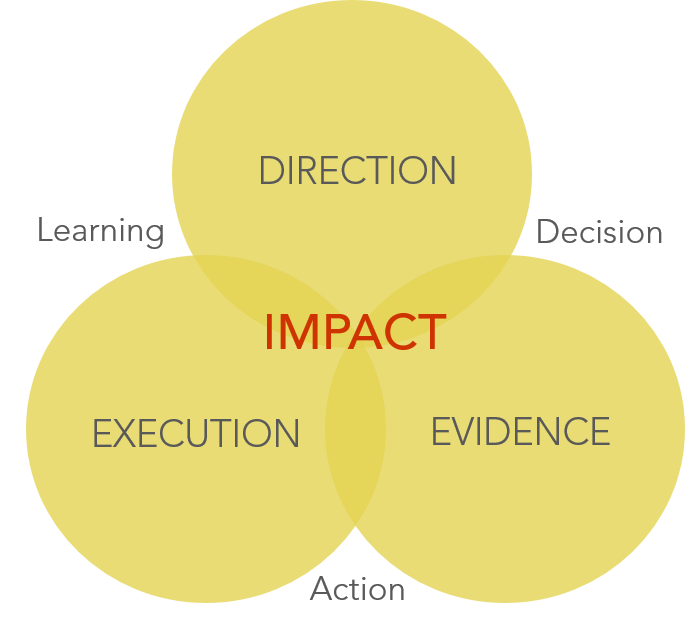9 Mindset Shifts to Bridge the Strategy-Execution Gap
by Stacey BarrUse these 9 actionable mindset shifts to close the gap between strategy design and execution, to achieve your strategic aims.

As leaders of organisations, it’s easy to forget that performance isn’t about strategic plans, culture surveys, managing talent, and KPIs. It’s about the impact the organisation creates.
Performance is about reaching our goals, fulfilling our mission, and achieving our vision, sooner and with less effort. High-performance is about our entire organisation doing this, exceptionally well, all the time. Evidence-based leaders know that this is their responsibility, and what they must master in order to achieve their strategic direction.
Evidence-based leadership is expressed through strategy design and execution.
Evidence-based leadership is about focusing on what matters most, of monitoring the measures that track what matters most, and finding increasing leverage in the change strategies to achieve what matters most.
Evidence-based leadership closes the strategy-execution gap. The Evidence-Based Leadership (EBL) framework gives leaders a practical way to evaluate and improve strategy design and strategy execution, so they lead to high-performance and measurable success.

It begins with the three focus areas that leaders give their own attention to, in strategy design: Direction, Evidence and Execution. This sets the foundation for the three focus areas leaders inspire everyone else to give their attention to in strategy execution: Decision, Action and Learning.
Direction is about designing an understandable and measurable strategy.
One of the things many leaders don’t know is just how misunderstood their strategic direction is to people throughout the organisation. If it’s not understood, it can’t be executed. These three mindset shifts put attention on the three reasons this misunderstanding happens so often.
Mindset 1: Results, not actions.
Write strategic goals that are results-oriented, not action-oriented (action comes later).
If the strategic direction is just a list of initiatives or projects, then people confuse action for results. But there is little point in action if we’re not aiming it at the results we want to achieve. Performance is a result, not an action.
Mindset 2: No weasel words.
Clearly articulate the strategic goals in language everyone will understand (they can’t buy in to what they don’t understand).
One of the worst problems with strategy is the excessive use of weasel words. People can’t buy into what they don’t understand. Use plain language to write goals, so everyone can understand what they’re asked to contribute to.
Mindset 3: Be ruthless.
Ruthlessly prioritise your strategic goals to focus on performance results that matter most, right now.
In “The 4 Disciplines of Execution”, Sean Covey, et al., explain how achieving strategic goals on top of day-to-day work follows the law of diminishing returns. The more goals we have, the fewer we achieve. Lots of unprioritised goals is a sure way to overwhelm and disillusion everyone.
Evidence is about making the strategy meaningfully measurable.
Mindset 4: Learning, not judging.
Use evidence to learn like a scientist learns, without judgement.
When measures are tools in people’s hands, not rods for their backs, people come to feel excited about using performance measures (aka KPIs) to improve business performance, and it’s easier for them to feel and be accountable for the right things. This starts with leaders being the role models for using measures to learn, not judge.
Mindset 5: Evidence before measures.
Design measures as quantifications of the observable evidence of results.
Measures aren’t actions or milestones or trivial counts. They are quantifications of objective evidence of the degree to which performance results are occurring over time. Use real measures, not brainstormed rubbish. What leaders do, everyone else follows.
Mindset 6: Measure what matters.
Only measure what can be aligned to the priorities (mission, vision, and strategic goals).
A clear and measurable mission, vision and ruthlessly prioritised set of strategy goals is the starting point – the inspiration – for aligning the entire organisation’s measurement of their contribution to the execution of the strategy. They can only do this if leaders give them the right focal point.
Execution is about focusing strategy execution on fundamental improvement.
Mindset 7: Leverage, not force.
Implement or execute strategy based on working smarter, not harder.
To improve performance, to increase our organisation’s capacity for excellence, requires leverage. If an improvement can only be sustained by continually putting in more effort, we didn’t find the leverage. Leverage begins with the strategic initiatives that leaders choose.
Mindset 8: Patterns, not points.
Make strategy execution about removing and managing variability, not about hitting the numbers.
We can only understand performance by understanding the patterns of variability in performance. Averages only tell a static story, like a photograph; but variability shows a movie. It’s the patterns we need to look for, not the points. Leaders can be role models for responding to patterns over time, and not month-to-month comparisons.
Mindset 9: Processes, not people.
Execute strategy to improve business processes and how work is designed, not controlling people and what work is done.
At least 90 per cent of performance problems are in the processes of the organisation, not in the people. So, teams must master the measurement of processes, and their outputs and outcomes. And, leaders encourage this by supporting process analysis and redesign.
Next, it’s about Decision, Action and Learning.
When leaders have designed a strategy through the 9 mindset shifts of the first three Evidence-Based Leadership habits of Direction, Evidence and Execution, strategy execution becomes so much easier. The strategy-execution gap closes when leaders inspire the organisation to practice the next 9 mindset shifts of the Evidence-Based Leadership habits of Decision, Action and Learning.

To get the full framework of all 18 actionable evidence-based leadership mindsets to evaluate and improve your strategy design and execution, please download the full White Paper “Evidence-Based Leadership: Make your strategy design and strategy execution lead to high-performance and measurable success” and feel welcomed to share with your colleagues
The full Evidence-Based Leadership framework is detailed in the book “Prove It! How to Create a High-Performance Culture and Measurable Success” by Stacey Barr.
Connect with Stacey
Haven’t found what you’re looking for? Want more information? Fill out the form below and I’ll get in touch with you as soon as possible.
167 Eagle Street,
Brisbane Qld 4000,
Australia
ACN: 129953635
Director: Stacey Barr





